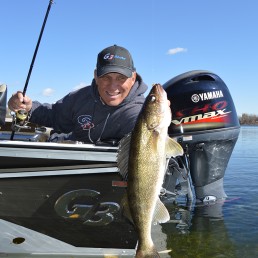Different Colors, Different Weights, More Fish
SHARE THIS POST
Another year of fishing has gone by. As I look back on the past fishing season, I can’t help but remember many other fishing seasons long ago. As I remember those days, I’m reminded of how much I’ve learned about fishing and fishing techniques. And then I’m reminded of how, when I thought I had mastered a particular fishing technique, I discovered that I hadn’t.
There are almost always exceptions to a technique. It’s the same with fish species. Just when I thought I had the walleyes, bass or whatever figured out, the fish taught me that I didn’t. Lure color and lure weight are factors that can contribute to better fish catches.
There are times when fish, any species of fish, will respond better to a particular lure color. A very successful angler once told me that, when it comes to walleyes and color, “Walleyes like any color as long as it’s chartreuse.” Another very successful walleye catcher said nearly the same thing but substituted orange as the color that walleyes like best. I came to find out that Walleye Catcher #1 only used chartreuse lures, and #2 only used orange lures. That’s why they had the most success with those colors. Much of the time they caught walleyes, but every now and then they didn’t. Eventually, #1 and #2 started experimenting with other colors when the walleyes weren’t biting. They started catching even more walleyes. There are times when fish want a particular color.
Another color quirk: If you’ve been catching ’em good on a particular color but the action slows, try a different color. Fish can become conditioned to color. Especially after you’ve been yanking some of their buddies through the roof!
It’s surprising how jig weight can impact how many fish we catch. It became obvious to me in my early days of chasing largemouth bass how important jig weight could be. In the lakes that my friends and I fished in central and north-central Minnesota, walleyes were the preferred fish. Largemouth bass were mostly ignored, and some anglers even considered bass to be undesirable. My friends and I preferred to chase the largemouths because they were usually very willing biters. When we went fishing, we spent almost all our time in summer on the deep weed line, casting a 1/8-ounce jig with a 4-inch plastic worm on 6-pound-test line. When the bass were really biting, we used a larger worm. The larger worm was more appealing to larger bass.
Are you enjoying this post?
You can be among the first to get the latest info on where to go, what to use and how to use it!
However, every now and then, the bass got finicky. We would work our 1/8-ounce jig/4-inch worm along the weed line and couldn’t get bit as often. On one of those slow-bite days, I picked up a rod that had a 1/16-ounce jighead tied on. I threaded my 4-inch worm on the lighter head and started casting. It didn’t happen immediately, but eventually, the bass revealed that on that day, they liked this combination better. The lighter jig made the bait fall slower. On slow-bite days, the bass preferred the slower fall.
We learned that we could slow the fall of the bait even more by going to a little heavier line or a bulkier bait. Heavier line and bulkier baits have more water resistance, so they fall slower.
When we go fishing, we need to remember that, if we’re not having success doing what we’re doing, do something else. In fact, that’s a pretty good rule for life in general.
For more insight and tips on how to make the most of the time you spend fishing, check out the articles in every issue of MidWest Outdoors, available by subscribing on our website.
MWO
SHARE THIS POST
You may also like...
Nothing found.
Did you enjoy this post?
You can be among the first to get the latest info on where to go, what to use and how to use it!
Bob Jensen
To see the latest episodes of “Fishing the Midwest” television, new fishing-related tips and articles from the past, visit fishingthemidwest.com. Follow them on Facebook @fishingthemidwest for fishing information and entertainment.
